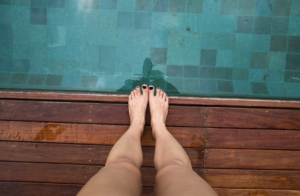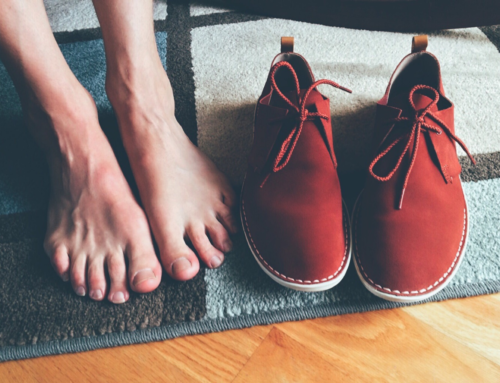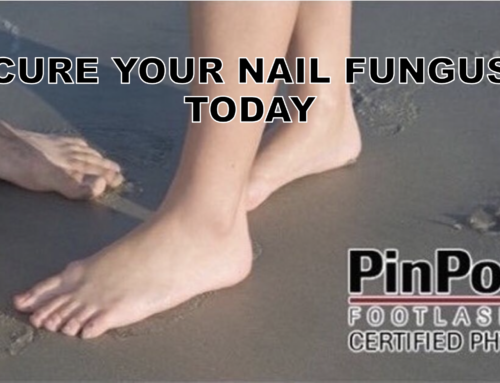Toenail fungus and athlete’s foot can go hand in hand. Athlete’s foot, also known as tinea pedis, is a type of fungal infection found on the feet. It is common in people who have sweaty feet. The condition is very common in athletes, thus the name.
Athlete’s Foot
An athlete’s foot is a fungal infection that usually affects the skin between the toes or the bottom of your feet. If left untreated, the fungi may spread and lead to a toenail fungal infection. When the fungus affects the toenail, that will become much harder to get rid of.
It appears as a scaly rash that is usually itchy and has a stinging or burning sensation. Because it is very contagious, it can spread easily through towels or clothing. Athlete’s foot is caused by the same fungus that causes ringworm, jock itch, and toenail fungus.
Some types of athlete’s foot cause blisters or ulcers, and there are some varieties that cause dryness and scaling on the soles the sides of the feet. Because the fungus spreads easily, it can spread to the toes and cause toenail fungus. Athlete’s foot gets worse without treatment. Then it spreads to the toenails. This would cause the toenails to be discolored and thickened. Once it reaches the toenails, it can be more difficult to treat than OTC medications will not be able to fix.

Toenail Fungus Infection
When you have toenail fungus, your nails become discolored, brittle, and thickened. The fungus that infects the nail can be tough to get rid of because it can get in between those layers. And because your nails become brittle due to the fungus infection, your nails could crack, making more space for the fungus to live in.
Athlete’s foot and toenail fungus go hand in hand. Both fungal infections spread easily and thrive in moist and dark environments. Your feet and toes can easily be infected by walking barefoot in gym showers, swimming pools, and locker rooms
Causes of fungal infections
Is the cause of toenail fungus vs. foot fungus different? The answer is that the causes of athletes’ foot and toenail fungus are very similar. Both conditions are contagious, so it is possible to catch them from somebody else when walking barefoot or sharing shoes. Fungus thrives in warm, damp environments. Fungus enjoys it when people do not change their socks and shoes.
Toenail fungus easily spreads between people who spend a lot of time together because the fungus uses surfaces to contaminate other individuals. The fungus then has a new host that it can use to grow, reproduce, and continue to be contagious! Make sure that you do not share worn socks and shoes with anyone if you have fungal infections.
Habits That Aggravate Toenail Fungus
If you want to prevent or treat your toenail fungus infection, get rid of these five habits that can aggravate the toenail fungal infection.
- Ignoring Dampness and Moisture: Consistent dampness in shoes and socks provides the ideal environment for toenail fungus growth. Keep feet dry and wear moisture-wicking socks and breathable shoes to prevent this.
- Neglecting Foot Hygiene: Maintaining proper foot hygiene is crucial in preventing and treating toenail fungus. Neglecting to keep your feet clean, dry, and well-groomed can promote the growth of fungus. It is important to frequently cleanse and dry your feet, with special attention paid to the areas between the toes. Keeping nails short and trimming them can also minimize the risk of infection.
- Sharing Footwear and Nail Tools: Sharing socks, shoes, and nail equipment can seem harmless, but it can easily spread fungal infections as fungi thrive in warm, moist environments and can be easily transmitted through contact. To avoid the risk of infection or reinfection, it’s best to refrain from sharing these items.
- Failing to Address Athlete’s Foot: If an athlete’s foot is not treated in a timely manner, it can easily spread to the toenails and cause itching, redness, and flaky skin. Therefore, it is important to treat athlete’s foot promptly to prevent the possibility of toenail infection.
- Delaying Professional Treatment: While over-the-counter treatments and home remedies may offer temporary relief, it is important to seek professional help to accurately diagnose and treat toenail fungus. Delaying professional intervention may cause the condition to worsen, so it’s essential to have a treatment plan tailored to your specific needs.
Signs of fungal infections
Toenail fungus usually shows itself in the form of discoloration, brittleness, thickening, or cracking of the nail. Athlete’s foot usually shows itself as a scaly rash coupled with itching and burning of the foot. The fungus causing athlete’s foot can also spread to the nail bed and cause a fungal infection of the nails.
Treatment for athlete’s foot usually involves topical antifungal medications. Topical antifungals are less effective at treating toenail fungus because they have to penetrate the nail to kill the fungus under the nail bed. For this reason, topical antifungals are usually too ineffective to kill nail fungus. Other treatments include oral medications, which can have very dangerous side effects. The best treatment for toenail fungus is the PinPointe laser, which typically requires only one treatment to kill the fungus with no side effects or downtime. To schedule a consultation with a podiatrist for the PinPointe laser treatment, give us a call at 1-(800) 672-0625 or visit our website for more information.

Nail Fungus Prevention
In order to prevent these conditions, you should avoid their common causes. Fungus thrives in moist, dark environments. In order to avoid fungus thriving in your toes, change your socks regularly and wear properly fitting shoes that are not too tight. You should also protect your feet in public places where fungus is common, such as public pools and showers.
Prevent Athlete’s foot and toenail fungus
- Wash your feet and toes regularly
- Wear slippers in wet public places
- Keep your feet and toes dry
- Get rid of old shoes or treat them with antifungal sprays
Professional Solutions: Laser Nail Therapy
For individuals seeking a proven and effective toenail fungus treatment, laser nail therapy offers a promising solution. Laser nail therapy is a non-invasive treatment that targets the fungal infection directly while sparing the surrounding tissue. Here’s how laser nail therapy can help:
- The laser targets the fungus, effectively killing it without causing harm to the nail or skin.
- The procedure is relatively painless and requires no anesthesia.
- Laser therapy sessions are typically quick, allowing you to resume your daily activities immediately after treatment.
- Laser nail therapy is backed by clinical studies and medical expertise, offering a higher likelihood of successful results.

Laser Treatment for Nail Fungus
If you have caught nail fungus, it can be easily treated using the FDA-approved PinPointe laser, which typically only takes one treatment. Other treatments, like topical solutions and oral medication, are not as effective. Topical solutions have a very low cure rate. This is because the solution does not penetrate all the way through the nail bed. This is because it can lead to liver toxicity. You would need to have consistent blood tests throughout the course of taking the medication.
Our nail doctor in Philadelphia, PA, recommends this treatment for toenail fungus. The PinPointe Laser treatment has the highest cure rate in the market. It has no side effects and no recovery period. As a result, you can go about your daily activities right after the treatment. Also, there’s no pain.
If you have any signs of nail fungus, call us at (267) 388-3798 at our Philadelphia, PA location, or visit our website for more information on our doctors at one of our over 150 locations.




